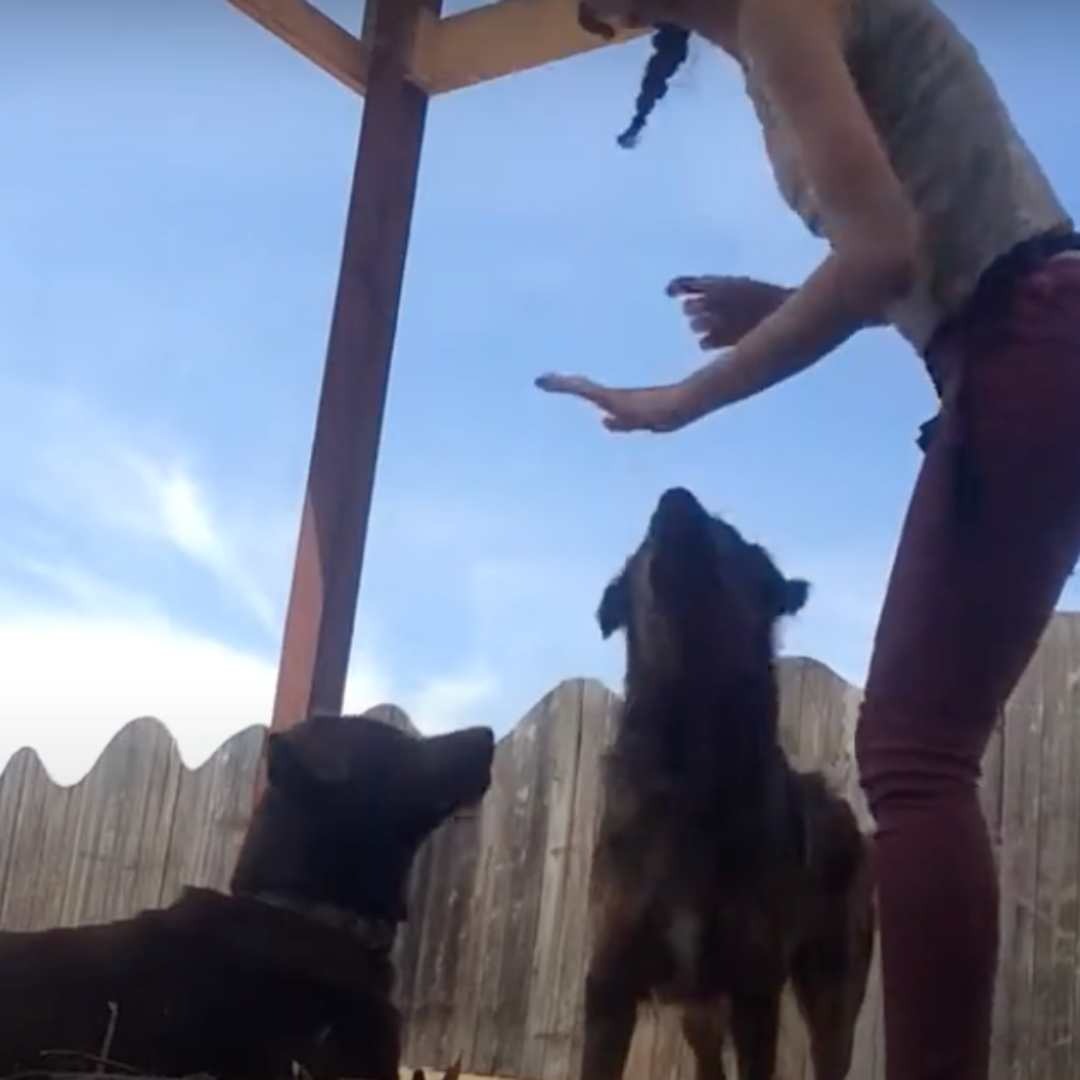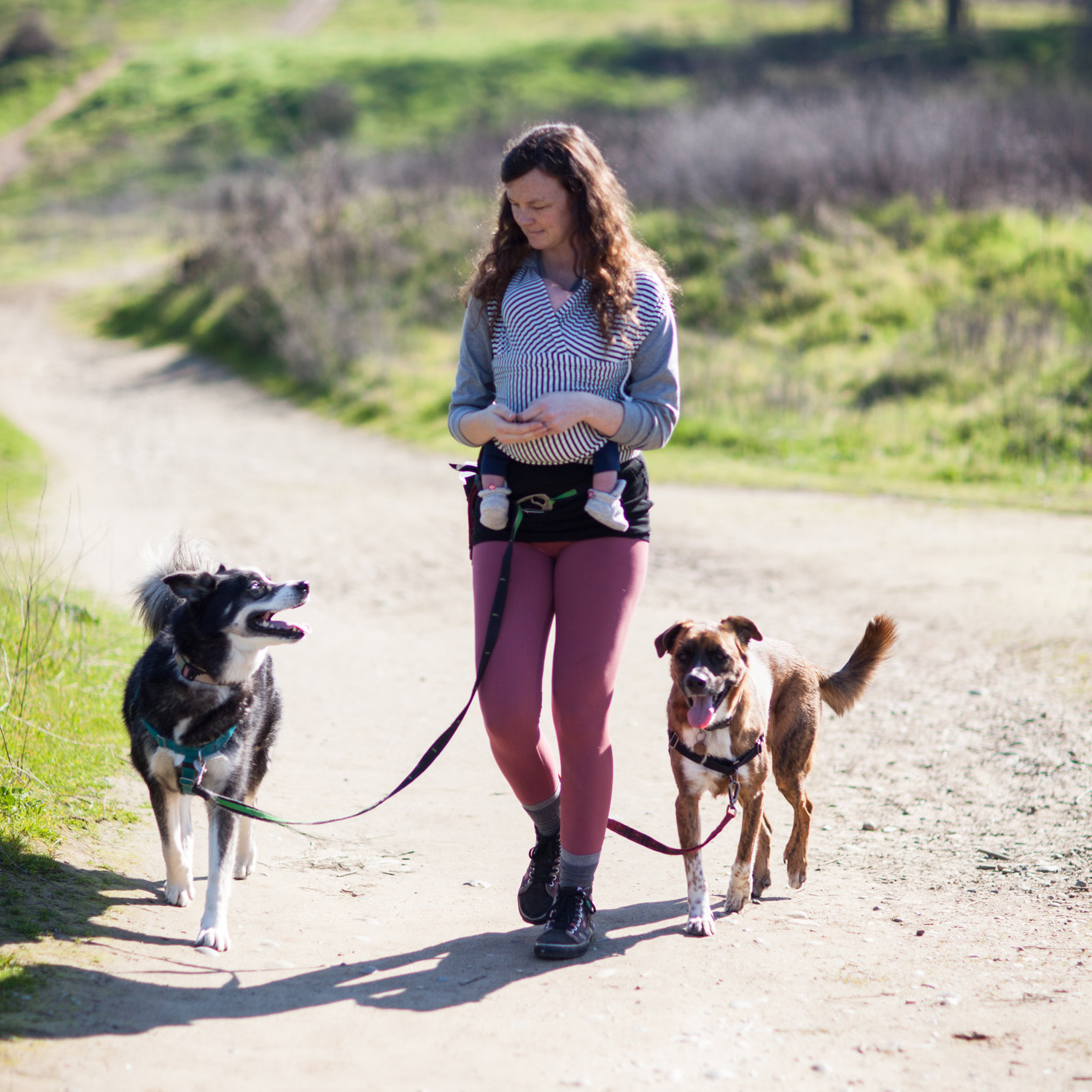So you've taught your dog to go to "place" (dog bed, mat... ) with duration and different kinds of distance, now it's time to start training your dog to happily "go to bed" even with interesting distractions!
What does that actually mean?
Distraction is such a big umbrella term. The dictionary definition is anything that diverts attention or can prevent concentration. For most dogs, that can be almost anything, since they're so sensitive to sounds in addition to what they smell and see.
This is a point where you get to think creatively, and also practically, about what you're going to use this go-to-place behavior for and what kinds of distractions are likely to happen in and outside your house. You'll want to prep your dog to settle and stay in position for anything that might happen in your real life.
Tell me more
In this video below, I'm using one dog as a distraction for the other - a great way to train a dog who is easily excited by other dogs! Or if you have a family member handy rather than another dog, use a person instead to practice your "go to bed" behavior.
As with every training exercise, the important thing is to create opportunities to set your dog up for success. My advice always is to anticipate situations and break the behavior down into small enough pieces so your dog can have many incremental wins. So keep that in mind when you're setting up your training sessions.
Let's get started with some pro-tip examples!
Here's how to start training your dog to go to place (dog bed or mat) and wait through all kinds of distractions till your release word:
Stop! Don't read this long article. Instead, get everything you need to know, including all advice on Go To Mat, in a customizable step-by-step plan for your dog created by our community of certified trainers and nutritionists.Your Dog's Plan
Tip 1: Change the environment
Learning to go to place and stay there in your house is one thing - but what about in the back yard? That levels it up a notch! Try changing the environment when teaching this behavior and see how your dog does. Work on this exercise in one room then after your dog is successful there go to another room, or the front porch, or out in the front yard. Start small! Something as simple as opening your door a crack can make a really big difference (use a leash or tether as a back-up if your dog is a bolter).
When you get REALLY comfortable, you can start using your "go to mat" training at the park, sporting events, restaurants, or other public settings -- but go slow on escalating to practicing in a public place to keep from putting your dog and you in a position beyond what feels right at any point in your training.
Try this
Pick a new place to practice your "go to place or bed" cue either a room inside your house or in your yard. Repeat the training steps from teaching your dog to go to his/her mat with duration. Continue repeating in new places as your dog is successful.
Tip 2: Change what you're doing
We've been working on our distance and duration, but for those exercises, we start out fairly stationary. Try adding in some movement - walking around the room, moving more erratically, even running!
If you're expecting or have an infant, you may want to mimic things you'll do with the baby - pacing and bouncing the baby, changing a diaper, rocking in your chair. Changing your focus is especially helpful in teaching your dog that the behavior remains the same whether or not your full focus is on your pup - you can do that by chatting with a family member, doing household chores, prepping dinner, or anything else!
Remember to treat your dog with high-value treats and often. Be sure to reinforce your dog with enough frequency that your dog is still in the game, and keep the session short enough to avoid frustration.
Try this
Repeat teaching your dog to go to his/her mat, but this time change your behavior when training. Jump around, sit down, pace back and forth - try it all! To level up, try making dinner or doing the laundry while practicing so your dog gets used to staying on the mat without your focus on him/her. Continue repeating while changing up what you're doing while training as your dog is successful.
Go To Mat
Interested in Go To Mat? Follow topics you're interested in to customize your dog’s step-by-step plan so it's most helpful and tailored to your dog when you're ready to get started.
Tip 3: Get noisy
Have members of your household make a little ruckus. If you're going to be using this cue when you have visitors, then the human volume may go up! Laughing, chatting, playing music are all great distractions to train your dog to not be distracted.
Try this
Repeat the training steps to teach your dog to go to the mat but this time with different noises happening at the same time. You can practice what happens when the doorbell rings or someone knocks. Or if you're expecting a baby in your family, you can use recordings of newborn cries while you practice this cue. All real-life noises are great to practice as a distraction while your dog is on their place or mat.
Tip 4: Practice when food is present
Is your dog a bit of a chow hound and drawn to just about any food? Knowing how to go to a specific place, lie down and wait on cue until hearing a release cue is one of the most valuable behaviors your dog can have to keep your food-filled family life smooth and safe. Whether it's a blanket you can toss on the floor, a mat, or your dog's bed, having that place where your dog is happy to settle and stay lying contentedly can be a lifesaver at mealtimes or when little ones are snacking (likely close to floor level which most dogs read as fair game). Practice when food is present but in a way that sets your dog up to be successful - nothing too close to small children or another dog at this point.
Why does this matter?
It can be risky to start with food involving kids/babies or anything that might have dangerous surprises before you know how your dog will react to these kinds of distractions. Build your shared confidence in your dog's go-to-place behavior and make sure you're prepared if your dog leaves the position before your release word as you grow into higher level distractions.
Try this
Repeat the training steps to teach your dog to go to his/her mat but this time try setting some tasty food on an accessible coffee table. Then you can work up to dropping food items on the ground. This is a great way to get your dog ready to ignore food in more challenging contexts, knowing there's actually a better reward when he or she settles on the mat!
Need more advice? Browse all guides in the Manners Channel on topics like Go To Mat, Food Manners, Party Manners, Stay, Public Manners, Travel Manners, and Basic Manners - created by our community of certified experts for you and your dog.Manners
Reward your dog well and often at EVERY step
Practicing "go to bed" for real-life distractions is hard work, so remember as always, to "pay" your dog well and often. For every key moment when your dog has an opportunity to choose leaving the mat to respond to the distraction vs. patiently lying in position, be sure to mark and treat generously!
Every time your dog might be tempted, feel free to have it rain high-value treats - you want your dog to know that choosing to lie and wait on his/her bed is more interesting and worthwhile than reacting to any distraction. And when your dog holds the "go to mat" behavior successfully through to your release word, mark and reward with a worthy celebration of treats and enthusiastic words of praise!
And don't forget to take a break when your dog or you needs it! It's always better to practice behaviors for shorter periods of time more frequently.
Learn how to teach your dog to confidently 'go to bed' amidst various distractions, from changing environments and activities to noise and tempting food.
Choose how you'd like to view this guide's video.

Next up in the Manners Channel on Dogly
Woohoo! You've gotten through the key steps to teach your dog to "go to bed/mat." Your dog can now go to his/her bed and happily stay there for a period of time, when you're at a distance, and even when lots of interesting distractions are going on.
The last guide in training your dog to have a successful "go to bed/mat" cue is specifically for families with babies and kids.
If you have any questions or want to share a sticking point or success about your "go to bed or mat" training overall, jump over to the Community discussion in the Manners Channel. Or, if you need more personalized 1-1 help, sign up to work with me here!

